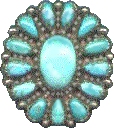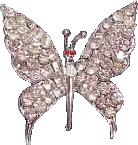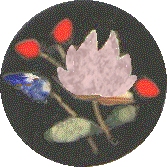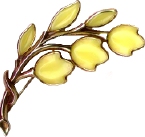
 |
| You might also like: | All About Jewels Glossary: T | All About Jewels Glossary: R | All About Jewels Glossary: M | All About Jewels Glossary: D | All About Jewels Glossary: F | Today's featured page: Endangered Animal Printouts |
| Our subscribers' grade-level estimate for this page: 5th - 7th |
Illustrated Dictionary of Jewelry |
 |
||||||
| A | B | C | D | E | F | G | H | I | J | K | L | M | N | O | P | Q | R | S | T | U | V | W | X | Y | Z |
PACIFIC CAT'S EYE Pacific Cat's-eye is the operculum of a sea snail called the Turban Shell (Turbo petholatus, found in the South Seas north of Australia). The operculum is part of many shelled animals - it is the calcified, disc-shaped "trap door" that opens and closes to protect the animal inside its shell. The Turban Shell's operculum is an eye-like disc with a natural cabochon shape - it is used in jewelry. This jewelry was popular in Victorian Era Britain. |
PADPARADSCHA SAPPHIRE Padparadscha sapphires (also spelled padparadschah) are a rare pink-orange variety of corundum or the synthetic equivalent. These gems are mined in Sri Lanka and are usually heat treated to improve and intensify the color. The name padparadscha comes from the Sinhalese word for lotus flower. Hardness = 9, Specific Gravity = 4. |
PALLADIUM Palladium is a valuable, durable, and malleable light-gray metal used in some jewelry; it is related to platinum, but is less dense and has a lower melting point. Unlike platinum, palladium reacts when exposed to aqua regia, sulfuric, nitric, and hydrochloric acids. It also develops a tarnish when it is heated. Pallasium is not a shiny as platinum. Palladium was only isolated as an element in 1802 by William Hyde Wollaston and Smithson Tennant. It was first used in jewelry in 1939 (during World War 2, platinum was used for war purposes, and was not available for jewelry making - palladium was temporarily used as a substitute for platinum). White gold is sometimes alloyed with palladium (instead of nickel), resulting in a gray-white gold. After World War 2, palladium was rarely used in jewelry making beacuse of some difficulties in working with it. Palladium was recently discovered to be useful in engine catalytic converters, and its price skyrocketed to over $700 per ounce (it had previously been much less expensive than platinum or gold). |
PAPER ROULE A paper roule is a bead made by rolling up paper (usually triangles). Roulé means rolled in French. |
PARENTI Parenti is a rare mark seen on beautiful, handcrafted silver jewelry from the early 20th century. Parenti jewelry was made by the two Parenti sisters, who immigrated from Florence, Italy, to Massachusetts, USA. The sisters had been trained as silversmiths in Europe, and later opened a shop at 97 Newbury Street, Boston, Massachusetts. Pieces from the 1930's to the 1940's-1950's are available. The sisters had a second shop on Cape Cod. |
PARURE A parure (meaning "personal adornment" in French) is a matching set of jewelry, usually containing a necklace, earrings, brooch and a bracelet (or two bracelets). See demi-parure. |
 PASTE Paste is glass that is cut and faceted to imitate gemstones. The Trifari set above has high quality paste emeralds, rubies and sapphires. |
PATE DE VERRE Pate de verre (also known as glass paste) is glass that is ground into a paste, molded, and then melted. The final piece is an opaque, dense glass with a frosted surface. |
PATINA Patina is the change of an object's surface layer that result from aging. Exposure to the air for an extended period of time oxidizes many metals, turning copper and bronze green, and gold reddish. Artificial patinas can be applied to newer objects by using acids or electrolytes. |
PAVÉ Pavé settings are stones set very close together. The stones hide the underlying surface. In better pieces, claw settings are used; in less expensive pieces, the stones are simple glued in. |
PAVILION The pavilion is the lower part of a cut gemstone, below the girdle. |
PEACOCK PEARL Peacock pearls are a type of black pearls that are dark-green (almost black). These pearls (like all black pearls) are produced by the oyster Pinctada margaritifera. |
PEAR CUT A pear cut gemstone (also called a drop cut) is teardrop shaped This type of cut is used for pendants, drop earrings, rings, and other pieces of jewelry. |
 PEARL Pearls are organic gems grown within oysters and a few other mollusks. Pearls are formed when a foreign object (like a tiny stone) has made its way into the mollusk's shell. The mollusk secretes nacre, a lustrous substance that coats the intruding object. As thousands of layers of nacre coat the intruder, a pearl is formed; this process takes up to seven or eight years (an oyster's useful life span). The most valuable pearls are perfectly symmetrical, large, naturally produced, and have a shimmering iridescence (called orient luster). There are many types of pearls, including natural pearls (made with no human interference), cultured pearls (pearls made by inserting a bit of a mother-of-pearl) into [nucleating] a living oyster or by inserting a bit of foreign tissue), baroque pearls (irregularly-shaped pearls), freshwater pearls, seed pearls (tiny pearls), Biwa pearls (a type of freshwater pearl from Lake Biwa, Japan from the freshwater mussel, Hyriopsis schlegeli), blister pearls (grown attached to the shell), black pearls (gray to black pearls), Mabe pearls (cultivated blister pearls), etc. Pearls can be gently cleaned with mild soap and water. The biggest natural pearl, known as the "Pearl of Allah" or "Pearl of Lao-tse," weighs 14 pounds (6.4 kg). |
PEARL OF ALLAH or PEARL OF LAO-TSE The biggest natural pearl, known as the "Pearl of Allah" and later, the "Pearl of Lao-tze," was found off the Phillipine island of Palawan in 1934. It weighs 14 pounds (6.4 kg). It was formed inside a giant clam, Tridacna gigas, the only mollusk big enough to create such a giant. |
PEARL OPAL Pearl opal (also called Tabasheer or tabashir opal) is an organic stone that forms in damaged joints (nodes) of bamboo plants. This hydrated form of silica appears as a rounded mass of opal, and looks like seed pearls. |
PEKING GLASS Peking (Beijing) glass was first made in China in the late 1600's, during the Quing Dynasty, when a German priest introduced glass-making techniques to he Imperial court. Early Peking glass was made to imitate porcelain (it often has a translucent, milky sheen). Later (after 1725), an overlay technique was developed in which two (or more) layers of glass are fused together, and then the upper layer(s) are partially carved away, creating a multi-colored bas relief (similar to a cameo). Peking glass and overlay glass is used for vases, bowls, dishes, beads, snuff bottles, and other objects. Peking glass is still made, but is now manufactured in Poshan, China, and shipped to Peking for final finishing. |
PEKING JADE Peking jade is the same as jade, but often refers to nephrite. |
 PELL Pell is a costumy jewelry company that was founded in 1941 by the brothers Bill, Joe, Toy, and Alfred Gaita. Pell makes high-quality pieces; older jewelry was pedominantly figural and made of clear rhinestones; later pieces are primarily gold-plated with faux pearls. The pin above is a older Pell butterfly with clear, round rhinestones and tiny, red glass eyes. |
 PENANNULAR BROOCH Penannular brooches are a type of early Celtic jewelry. They are circular brooches with a long pin (oftern hinged to the base of the pin). These pins were used to fasten two pieces of cloth together (before buttons were invented). The earliest-known piece is the Hunterston brooch from A.D. 700 |
 PENDANT A pendant is a hanging ornament. Necklaces, pins, and earrings often have a pendant. The Christian Dior pendant shown above is costume jewelry. |
PENDELIQUE A pendelique cut in one that is lozenge shaped. This cut is frequently used for flawed stones. Pendelique cut stones are often used as pendants. |
 PERIDOT Peridot (also known as the "evening emerald" and chrysolite) is a yellow-green semi-precious stone with an oily luster; peridot is a transparent, green form of olivine. Peridot exhibits double refraction; when you look through the stone, things appear double. For example, when looking into a faceted peridot gemstone, the number of bottom facets appears to be double the actual number of facets. Most peridots are from a volcanic island in the Red Sea, Zebergit/St. John, the "Serpent Isle." Peridots have been found in meteorites. Peridot has a hardness of 6.5. Peridot cat's eye also exists. |
PETRIFIED WOOD Petrified wood (also called xyloid jasper or jasperized wood) is wood that has fossilized - all the original chemicals in the wood have ben replaced with minerals, making a stone-like replica of the original wood. |
PEWTER Peweter is an metal alloy that is composed mostly of tin combined with lead, antimony, bismuth, copper, and/or silver (the formulation varies quite a bit). When pewter is polished it has a silvery luster. Most pewter is over 90 percent tin. Pewter is a soft alloy that is worked by casting, hammering, or turning. |
 PIDIDDLY LINKS Pididdly Links is a costume jewelry company that was formed in 1969 in Lake Katrine, New York. Pididdly Links creates antique reproduction pieces (including pins, earring, necklaces, bracelets, and barrettes) in Victorian, Art Nouveau, and other decorative styles. The jewelry mostly has a gold-tone finish and Swarovski crystals. |
PIERCED WORK Pierced work is jewelry (or other metal work) that has patterns cut out of the metal. Pierced work is done with a piercing saw, a tiny chisel, or a stamping machine (with a die as the pattern). When a saw is used, the pattern is drawn on the metal, then a small hole is drilled in each of the future holes. The saw is then used to cut out the desired areas. |
 PIETRA DURA Pietra dura (meaning "hard rock") is an ancient technique of inlaying semi-precious stones (like alabaster, agate, onyx, lapis lazuli, jasper, topaz, and carnelian) into marble or other soft stone. This art form superficially resembles mosaics. |
 PIN A pin (also brooch) is an ornament that can be pinned to a garment. The pin above is by Trifari. |
PINCHBECK Pinchbeck (also known as "false gold") is a alloy of copper that looks like gold. Pinchbeck was invented by the British watchmaker Christopher Pinchbeck (1672-1732) in the early 18th century. Pinchbeck consists of 83% copper and 17% zinc. Ironically, there have been many imitations of Pinchbeck (which itself is an imitation). |
PINK GOLD Pink gold (also known as rose gold) is gold with a tinge of pink. It has been alloyed with a mix of 90% copper and 10% silver. |
PINK TOPAZ Pink Topaz (Aluminum silicate fluoride hydroxide) is a very hard pink gemstone. Pink topaz is usually created by irradiating common yellow topaz. Topaz has a hardness of 8 and a specific gravity of 3.5-3.6. |
PIQUE Pique is a tortoise shell inlaid with precious metal (usually gold or silver). Pique is made by inserting hot metal into the tortoise shell; the hot metal melts the shell upon contact. |
PLANE OF SYMMETRY A plane of symmetry is a plane that divides a solid into two mirror-image pieces of the solid. |
PLATING Plating or electroplating (also called Galvanotechnics after its inventor, Luigi Galvani) is a process in which one metal is coated with another metal using electricity. In jewelry, inexpensive metals are frequently electroplated with more expensive metals, like gold (gold plating), copper (electrocoppering), rhodium (rhodanizing), chromium (chromium plating), or silver (silver plating). The thickness of the metal coat varies. Electrogilded coating is the thinnest (less than 0.000007 inches thick); gold-cased metals have a coating thicker that 0.000007 inches. |
PLATINUM Platinum is a very strong, dense precious metal with a white color. Platinum jewelry is usually 90%-95% pure, is very sturdy, and holds stones well; to strengthen the metal and increases the workability of the platinum, platinum is usually alloyed with 5 to 10 percent of another platinum group metal (like ruthenium, palladium, or iridium) and/or cobalt. Platinum is 60% heavier than gold. Platinum was only discovered in the 1700's in Russia. Platinum is abbreviated Pt. and Plat. |
PLATINUM GROUP METALS The Platinum Group Metals (abbreviated PGM) are the precious metals platinum, iridium, palladium, ruthenium, rhodium, and osmium. They are all rare (platinum and palladium are the most common) and expensive; they are also often found together in nature. |
PLEOCHROISM Pleochroism is the property of having more than two colors, especially when viewed from different angles. In pleochroic minerals, a single stone will show many colors (in the case of Iolite, violet-blue, light blue, and yellow-gray will be visible). |
PLIQUE À JOUR Plique à jour is a back-less enamel that is a bit like stained glass. In plique à jour, the enamel work is translucent (light shows through it) since the backing of the enamel is absent. Cells of enamel are surrounded by delicate wire. Plique à jour is made by shaping cloisonné wire on a thin sheet of metal (or mica). Enamel (powdered glass) is fired into the wire cells. After the enamel has melted and cooled, the backing (metal or mica) is peeled away and the translucent enamel is left suspended in a supporting framework of cloisonné wire. |
POINT A point is a hundredth of a carat or 0.002 gram. |
 PORCELAIN Porcelain is often used in jewelry. It is made of fine clay (containing kaolin) which is fired in a kiln to about 2,000°F. The porcelain is covered with a glassy, decorative glaze. |
POROUS Porous stones have tiny holes in them. These holes allow water, oils, and other substances to penetratethe stone, frequently changing their appearance over time. Many stones are porous, including turquoise. |
POT METAL Pot metal is an inexpensive metal alloy, usually containing lead. It is sometimes used for inexpensive costume jewelry. |
 POURED GLASS Poured glass is a jewelry technique in which glass is suspended within a metal framework. The result is a stained-glass-like effect with translucent glass. The Trifari brooch above is made of yellow glass. |
PRASE OPAL Prase opal is a green, translucent opal that looks quite similar to chrysoprase (hence the name "prase") or jade. This type of opal is found in Tanzania, Africa. This gem does not display the iridescence found in some opals. |
PRECIOUS STONE A precious stone (also called a gemstone) is one that is valuable and rare. |
 PRINCESS CUT A princess cut is a square-cut stone. This fancy cut is relatively new and is also known as a Quadrillion or Squarillion cut. |
PRINCESS LENGTH A princess length necklace (usually referring to a string of pearls) is 18" long. |
PROMISE RING A promise ring is a pre-engagement ring, usually with a relatively small stone. |
PRONG SET Prong set stones are held securely in a setting by tiny metal claws. |
PROVIDENCE Providence, Rhode Island, is a major US center for costume jewelry, silversmithing, and other metalwork. Many costume jewelry companies are/were located in Providence, including Monet, Danecraft, Barclay, J.J., Lang, Trifari, Speidel, Van Dell, and many, many more. |
PRYSTAL A prystal is an imitation crystal made from translucent, phenolic plastic. |
PT. Pt. is an abbreviation for platinum. |
PURPLE DIAMOND Purple diamonds are rare, fancy diamonds and are quite valuable. Diamonds are precious, lustrous gemstones made of highly-compressed carbon; they are one of the hardest materials known. Diamonds have a hardness of 10, a specific gravity of 3.5, and a refractive index of 2.417 - 2.419. |
PYRITE Pyrite (also known as fool's gold) is a shiny, metallic mineral that is a form of iron. Marcasite stones come from pyrite. |
PYROPE GARNET Pyrope garnet is the familiar deep red garnet. Red garnet is the birthstone for January. Garnet has a hardness of 6-8 and a specific gravity of 3.5 - 4.3. The formula for garnet is: A3B2(SiO4)3. Pyrope garnet is also called (misleadingly) American Ruby, Arizona Ruby, Australian Ruby, Bohemian Ruby, California Ruby, Cape Ruby, Colorado Ruby, Elie Ruby, Montana Ruby, and Rocky Mountain Ruby. |
Illustrated Dictionary of Jewelry |
 |
||||||
| A | B | C | D | E | F | G | H | I | J | K | L | M | N | O | P | Q | R | S | T | U | V | W | X | Y | Z |
Enchanted Learning®
Over 35,000 Web Pages
Sample Pages for Prospective Subscribers, or click below
|
Overview of Site What's New Enchanted Learning Home Monthly Activity Calendar Books to Print Site Index K-3 Crafts K-3 Themes Little Explorers Picture dictionary PreK/K Activities Rebus Rhymes Stories Writing Cloze Activities Essay Topics Newspaper Writing Activities Parts of Speech Fiction The Test of Time
|
Biology Animal Printouts Biology Label Printouts Biomes Birds Butterflies Dinosaurs Food Chain Human Anatomy Mammals Plants Rainforests Sharks Whales Physical Sciences: K-12 Astronomy The Earth Geology Hurricanes Landforms Oceans Tsunami Volcano |
Languages Dutch French German Italian Japanese (Romaji) Portuguese Spanish Swedish Geography/History Explorers Flags Geography Inventors US History Other Topics Art and Artists Calendars College Finder Crafts Graphic Organizers Label Me! Printouts Math Music Word Wheels |
Click to read our Privacy Policy
| Search the Enchanted Learning website for: |